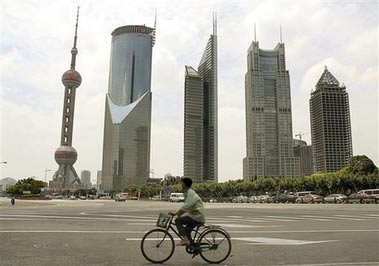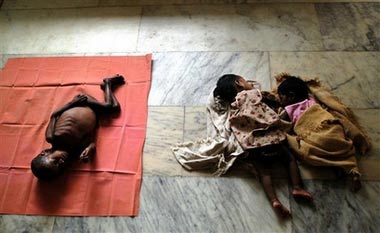China, India strive to keep boom going
(AP)Updated: 2006-12-12 11:00
Shanghai -- Poverty, water shortages, environmental crises: Asia's booming
giants, China and India, confront daunting challenges as they strive to keep
their economies expanding fast enough to raise growing numbers of their 2.3
billion people out of poverty.
For each, the potential is huge, but then,
so are the risks.
| |||
India's economy is close behind. It grew 9.2 percent in the quarter that ended in September -- its strongest performance since 1991. The International Monetary Fund estimates that inflation-fighting measures may slow growth to 7 .3 percent in the fiscal year starting April 2007, from 8.3 percent estimated for this year.
Such stratospheric figures highlight China's rise as an export power, and India's newfound cachet as a star outsourcing center for the high-tech industry, as well as robust growth in its agricultural, industry and services sectors.
But the gleaming new office buildings and legions of newly affluent consumers in cities like Shanghai and Mumbai, snapping up the latest cell phones and brand new sedans, contrast sharply with the poverty that persists in both countries, particularly in rural areas.
Some 10 percent of China's 1.3 billion people live on less than a dollar a day, according to the World Bank. In India, with a population of 1 billion, about 40 percent do.
"There is an India of bursting growth, and there is an India of widespread want," Sonia Gandhi, the Italian-born leader of India's governing coalition, told a recent business conference in New Delhi.
More than a third of India's population can't read or write, and a fifth of its people have no access to safe drinking water. Poverty and unemployment are fueling insurgencies in many parts of the country.
Still, both economies have proven remarkably resilient, adapting outdated trade and industrial policies while blunting the impact of those reforms on their poorest citizens with price controls and subsidies to farmers.
Tens of billions in foreign direct investment, coupled with strong domestic spending, are supporting heavy investment in construction of the railways, ports and other infrastructure needed to support further growth. Steel making, cement and many other industries have prospered in turn.
 A worker rides bicycle past high-rise buildings Tuesday July 18, 2006 in Shanghai, China. [AP]  |
And in both countries, share prices have surged on optimism over growth and rising corporate competitiveness, with Indian stocks trading at all-time highs and those in Shanghai just below the peak they hit in 2001.
But leaders in both China and India are awakening to the realization that greater equity, plus better protection for the environment and scarce resources, are needed to sustain growth and help lift tens of millions more out of poverty. Both governments have stepped up rural spending and increased subsidies to the poor, while attempting to attract more investment into backward, inland regions cut off from the growth centers along the coasts.
The Indian government plans to spend $26 billion in 2005-2009 building rural homes, expanding irrigation coverage and providing drinking water, electricity and phone connections for all of the country's rural villages. It is too early to say if those initiatives, as well as a rural employment scheme, will be able to meet their objectives or will degenerate into populist rhetoric.
Chinese leaders have acknowledged their concerns about the widening gap between rich city dwellers and the rural poor.
Raising rural incomes has become a top priority, both for ensuring stability and for boosting domestic consumer demand required for sustained growth in the long-term. China's leaders have abolished farm taxes and made schooling free for rural families, hoping to help redress the huge gap with city dwellers. More such gestures are likely in the run-up to the Communist Party Congress in late 2007.
"Can China sustain 8 percent to 10 percent growth? It has to do more to stimulate consumption. A lot more," says Yiping Huang, an economist with Citigroup in Shanghai. "It needs to do more for social welfare so that people can feel comfortable and spend more."
At the same time, China is just barely beginning to grapple with the huge environmental costs of its industrialization: fouled water and air, rural villages drowning in waste and massive shortages of water and other resources.
Another risk that China faces is an overheating economy. Worried that soaring investment in real estate and construction will leave banks with bad loans, authorities have raised interest rates and implemented other measures to curb borrowing. In policy setting meetings in early December, officials said they would continue those policies.
Economists have repeatedly warned that despite multibillion-dollar write-offs of bad debt and spectacular international stock offerings, China's state-owned banks could yet fall prey to bad debts, especially if growth slows.
"When the economy is doing well, we don't see big financial risks. But when economic growth slows nonperforming loans rise," Huang says.
So far, China has managed to cap inflation at about 2 percent, well below the government's threshold for concern.
India faces an uphill task in reining in insurgencies and terrorism that threaten to impact the country's investment climate.
Beyond the continuing unrest in Kashmir, analysts worry about growing rebellion in parts of southern and eastern India that they say is fueled by economic deprivation and uneven growth.
Insurgent groups are also active in the country's remote northeast, where local people often accuse India's federal government of exploiting the region's rich mineral resources without bringing much benefit to its inhabitants.
India is also vulnerable both to domestic risks and to so-called "external" risks such as a resurgence of trade protectionism, which would crimp export growth, and volatile oil prices.
But India has yet to bring surging prices under control: Indian Finance Minister P. Chidambaram termed 5 percent-plus inflation rates as "worrisome."
Yet with growth at its highest level in 15 years, Chidambaram was upbeat.
"Just savor the moment," he said.
| ||
|
||
|
||
|
|

